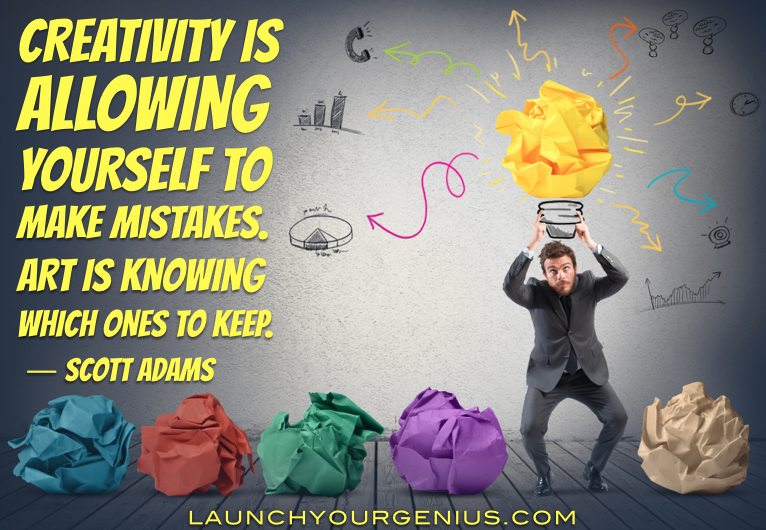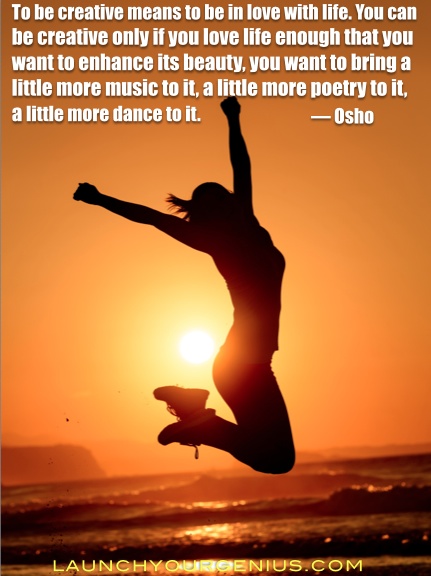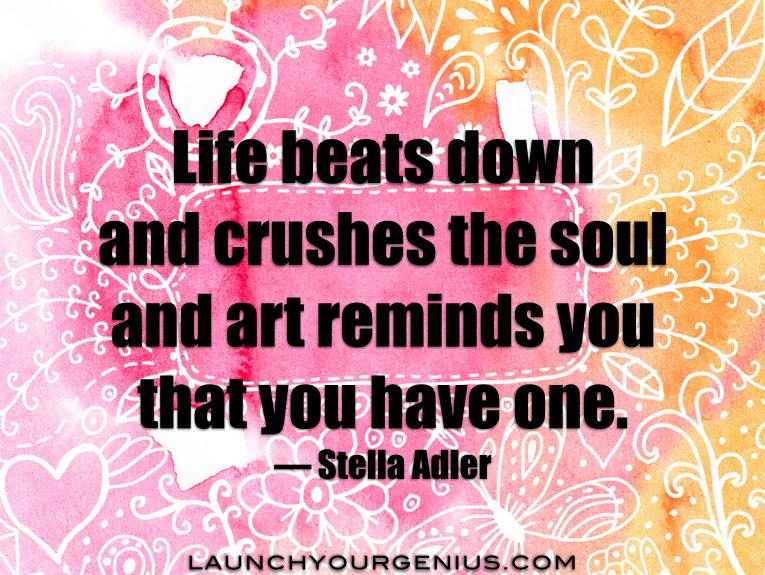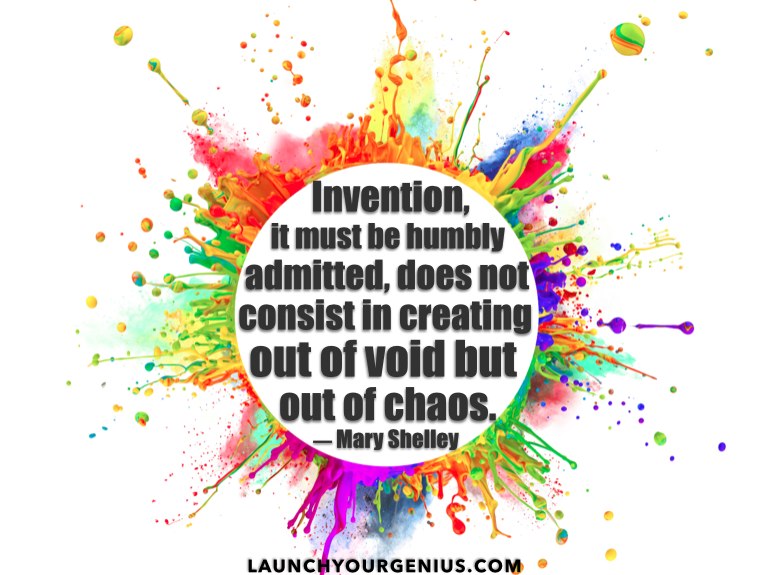“Creativity is allowing yourself to make mistakes. Art is knowing which ones to keep.” ― Scott Adams
Do you believe that creativity is inborn and only a few people are lucky to be creative?
Or, do you believe that everyone is creative and can learn to be creative in their life and at their work?
Did you wonder how to get a jump start on creativity and the creative process?
If you are like me, I am sure that this thought crossed your mind at some point in your life. How can we enhance creativity in our work and in our life?
What are some of the factors and conditions that help the creative process?
Creativity is a hot topic in recent times. With an ever changing landscape, expressing your unique blend of creativity has become vital for growth and progress.
Creativity has become essential to the individual and for teams within the framework of an organization.
We know that studies and research on creativity can be gold mines of valuable practical information.
Yet, it is disheartening to know that majority of scientific studies on creativity will not have a wide audience. In fact, the average is approximately seven people who will see any given research study.
I have started a new post series on the latest scientific studies that can add value to our life.
I will not be writing these posts in sequence. Instead, I will write these episodes on the latest science studies as they become available.
“To be creative means to be in love with life. You can be creative only if you love life enough that you want to enhance its beauty, you want to bring a little more music to it, a little more poetry to it, a little more dance to it.” ― Osho
Study 1 (2014):
Hope and positive affect mediating the authentic leadership and creativity relationship by Armenio Rego , Filipa Sousa, Carla Marques, Miguel Pina e Cunha (2014) in the Journal of Business Research.
Goal of the Study:
Understand the relationship between authentic leadership (AL) and the creativity of employees.
The study tests the idea that AL might have a direct effect on creativity or have an indirect influence through the mediating role of positive effect and hope.
Some Background:
What is Authentic Leadership or AL and who are authentic leaders?
- Authentic leaders are self-aware.
- They are aware of what their strengths are and what weaknesses they have.
- They have a clear sense of how they are deriving and making meaning of the world.
- They also understand how people perceive them and what impact they can have on others.
AL means balanced processing. This is the ability to objectively analyze important data before deciding. Leaders also have the ability to bring to the table views that question and challenge deep set beliefs.
AL also means that leaders establish a high standard for ethical and moral behavior and make decisions based on those values.
The leaders also have relational transparency. This is the ability to present their true self to others.
Leaders also express authentic thoughts and feelings and thus promote openness with others. This encourages others to open up to them with their ideas and opinions and problems.
The authors say that many studies support their idea that AL promotes creativity:
“Authentic leaders promote employees’ perceptions of psychological safety and their intrinsic motivation, which in turn make them more creative. Psychological safety refers to how individuals believe that the team or organizational context is safe for interpersonal risk-taking.”
AL promoters:
- Transparency
- Psychological safety or the ability to be oneself
- The reduction in maintaining an image
- Allowing dissent and other conflicting ideas and opinions
- Analyze relevant data objectively
The Experiment: 219 employees and 219 supervisors participated in the study.
The employees worked in different retail organizations such as food, clothing, toys, and furniture.
As part of the study, employees reported the AL of the supervisors. They were also asked to record their positive effect and hope. Supervisors then rated their employee’s creativity at a different location.
Researchers measured AL by a questionnaire that asked employees to list the AL of their leaders:
- Their leaders’ ability to seek feedback
- To mean what they say
- Have consistent beliefs and actions
- Be able to listen to differing views before deciding
The employees recorded the frequency of 16 such behaviors over three months.
The measure of Employee positive effect was how frequently they felt the following over three months:
- Enthusiasm
- Happiness
- Excitement
Five items determined the measure of Employee creativity. Among them were their ability to come up with novel ideas to enhance performance and if they came up with new ways to improve quality.
Results:
The major finding of the study was that AL had a positive correlation and directly predicted the creativity of employees.
AL also had a positive correlation with the employees’ positive effect and hope. The mediating effect of hope also predicted the creativity of employees.
The authors say that research has indicated that people can develop hope by the following:
- Goal setting
- Forming small and manageable sub-goals
- Delegation and empowerment
- Confidence building and contingency planning
- Realignment or re-goal when facing difficulties
Research has shown that we can enhance positive affect by the factors listed below:
- Allowing employee development and learning
- Effective interpersonal relationships between leaders and employees
- Supporting balance between family and work and enhancing the significance of tasks
“Life beats down and crushes the soul and art reminds you that you have one” ― Stella Adler
Study 2 (2014):
Exploring the critical influential factors of creativity for college students: A multiple criteria decision-making approach by Hung-Yi Wua, Hung-Shu Wub, I-Shuo Chen, Hui-Chun Chen. Source: Thinking Skills and Creativity 11 (2014), pages 1– 21.
Objective of the Study:
What are some of the key factors that influence and shape the development of creativity among college students? Based on previous studies, researchers tested four major factors or dimensions:
A. Individual qualities
B. Family background
C. School element and
D. Community
The Research Setup:
Consultation of 40 senior experts from academics, finance, service, manufacturing and educational industries.
Most of the experts (60%) were college professors who had direct knowledge of student creativity.
The rest of the experts were senior managers of companies with direct involvement in creativity related planning and activities. Most of the experts were highly experienced in their fields.
Researchers determined important creativity indicators, and factors by a thorough and exhaustive literature review.
The efficacy of these factors was then verified by experts and formal questionnaires generated.
The researchers conducted the expert surveys in two parts.
Some of the topics addressed were the evaluation of factors that influenced the creativity of students and the background of the experts.
Some of the factors and criteria used:
- Personal characteristics such as personality, motive and knowledge.
- Family background: Parental rearing style, family environment, subject identity.
- School element: Peer relations, student-teacher interactions, and environment.
- Community: social educational environment, social cultural environment.
Conclusions and Results: The study showed that among the different factors, community had the major effect on the creativity of students.
Thus in the order of impact on creativity:
a. Community followed by
b. Family background
c. School element, and finally
d. Personal Characteristics
The highest impact on creativity was through the effects of oppressive environmental behavior.
According to the authors, this is an sign that community is a good place to start for creativity.
In previous studies, researchers showed that the following were unfavorable for creativity:
- Harshness from the external environment
- Competition
- Stresses of life
The authors say:
“Nevertheless, healthy competition in oppressive environment can actually unlock potential, promote perseverance, and, in turn, foster the creativity of a person. Moreover, the prerequisites of doing this are the existence of an innovative, diversified, proactive, and unselfish cultural environment wherein differences are respected and a lively and joyful learning environment is created.”
Thus a healthy competition in a diverse and supportive environment is beneficial for creativity. It seems that the appropriate stimulations from community and environment are essential for creativity.
The other prominent results:
A. Parents should become role models of creativity for children in families. People in authority roles should show creativity and innovation for impact.
B. The best way to enhance creativity is through the observation and the imitation of creative role models.
C. Schools and learning environments should provide a creatively safe and harmonious environments.
D. Encourage Life long learning and implementation of that knowledge.
E. Having an independent and decisive personality promotes creativity in individuals.
F. Having hobbies and curiosity helps with creativity. These with knowledge and cultural stimulation from community such as school and home adds to the mix of creativity. This mix of factors make people experience the creative process. They also get an in-depth experience and meaning of construction.
G. Creativity developed through lifelong learning is impactful and effective. The creativity developed through formal education is not quite as effective.
The authors say:
“Attitude and desire to learn are stronger influential factors of creativity potential compared to the level of professional knowledge. Thus, it can explain the reason why individuals with low levels of education but good practice in learning knowledge through personal interest cultivation and continuous education may turn out to be inventors.”
Study 3 (2013):
How artists create: Creative process and multivariate factors by Marion Botella, Vlad Glaveanu, Franck Zenasni, Martin Storme, Nils Myszkowski, Marion Wolff, and Todd Lubart. Source: Learning and Individual Differences 26 (2013) 161–170.
Aim of the study:
Understand how creativity works by identifying the factors and stages that artists find important for their creativity. The study aims to advance the understanding of creativity using art as an example. We can then use this information for practical purpose and teaching creativity and art.
Background: A multivariate approach to individual creativity involves the combination of the following factors:
A. Cognitive
- Intellectual ability
- Defining and redefining a problem
- Selective encoding or selection of relevant information critical to solving a problem
- Similarities between domains, selective combinations or associations between the various ideas gathered
B. Conative
- Personality traits
- Motivation
- Openness to new ideas and experiences
- Dynamic imagination, and emotional awareness
- Originality, intellectual curiosity
- Personal value system
- Tolerant to ambiguity and non-conformism
C. Emotional
- Emotional clarity
- Able to perceive feelings
- Emotional intelligence and perception of the environment
D. Environmental
- Physical stimulations and social stimulations that allow generation of ideas and their maturity
- Social judgment and appreciating creativity
These factors can add and also compensate for the lack of one another.
The authors say while citing another past study:
“For Sternberg and Lubart (1995), creativity involves more than a sum of all these components: certain constituents can partially compensate each other. For example, a strong degree of motivation can mitigate a lack of knowledge. These components interact among themselves; the combination of high intelligence and strong motivation may enhance creative performance in a multiplicative manner. Thus, the multivariate approach focuses attention on the various constituents involved in artistic creative activity and aims to examine the interactions between them.”
The method:
Researchers conducted 27 interviews with professional artists with artistic recognition and experience. They performed two types of analyses, a quantitative and a qualitative approach.
The quantitative analysis consisted of interviews and associated self-report questionnaires. The qualitative approach was application of a coding grid to a representative subset of the interviews.
The purpose of this was to uncover stages of activity and the interaction between creator and the material and social world.
Results:
A. The 4 P’s of Creativity or Person, Process, Press and Product were spontaneously referred to by artists.
They also referred to the multivariate approach.
B. The cognitive component is important for creativity.
Like previous studies, the following abilities of a person were important for creative production:
- Generate new ideas
- Combine ideas together
- Assemble ideas together
- Accept new ideas
- Compare current and previous information and knowledge.
- Analogies and selective encoding
C. Conative factors also help and favor creativity. These factors are:
- Esthetics and values
- Openness to new experiences
- Sources of inspiration
D. Artists mentioned feelings and emotional components to be useful in their work. Yet, the analysis of the data showed that feelings were not quite as important. Some artists believed that emotional factors enhanced creativity while others disagreed.
Both positive and negative feelings can help creativity and creative work. This is an important finding because we can get bogged down by negative emotions.
Satisfaction or anger could be the beginning point for artists creativity.
Artists described guilt as a blocking feeling. The major blocks of creativity seem to be emotional factors.
Emotional intensity, control, emotional valence and specific content decide if emotions and feelings have an impact.
E. Finances, life events and special environments were not seen as necessary for creativity.
Artists considered the social environment to be the most important and relevant of the environment aspect.
This concludes the episode-1 of the The New “Hot Off The Press” Science Of Creativity!
I leave you with the floor open for comments below and a few quotes.
“Invention, it must be humbly admitted, does not consist in creating out of void but out of chaos.” ― Mary Shelley
“But unless we are creators we are not fully alive. What do I mean by creators? Not only artists, whose acts of creation are the obvious ones of working with paint of clay or words. Creativity is a way of living life, no matter our vocation or how we earn our living. Creativity is not limited to the arts, or having some kind of important career.”
― Madeleine L’Engle, Walking on Water
*ANNOUNCEMENT! My latest free e-book “21 LIFE ALTERING SHIFTS OF MINDSET AND PERSPECTIVE ” (File size: 8.2 Mb, 102 pages) is available now for download! If you are a subscriber, please check your latest LYG e-mail newsletter for a link. If you are new to LYG, please signup below for a free download.









Yvonne I. Wilson says
Hi Harish
We are the offspring of our Creator and I believe that creativity is a gift to us that we were all born with. What we do on a daily basis with that creative ability is what makes the difference. I also believe that creativity is wired to our thoughts and eventually that thought is transmitted as molecules by what we speak and then comes an action.
A man speaks out of his abundance. So the idea is – if a man’s thoughts are consistently positive and strategic, then most likely his words and his actions will all be in alignment. That for me results in creation and the creative ability of humans.
Thanks for sharing and for opening our minds to the science of creativity. Have a blessed weekend.
Harish says
Hi Yvonne,
Thanks for your comment!
I agree that creativity is a gift that we all born with. And like you mention, it is the daily actions and habits that bring the creativity out in the world. When we express our unique blend of creative powers, despite the odds and creative blocks, we gain more creative practice. I like what you mentioned about thoughts being positive and strategic because it takes many factors to express creativity that is effective. The alignment of words and actions is one of those factors where to express authenticity, things need to align. If we are thinking one thing and try to act another way, it is difficult to flow freely in the creative process. So in a way, it needs less hesitation and more letting go.
Thanks and have a wonderful weekend,
Harish
Ravi Chahar says
Hi Harish,
We live in a world which is full of science concepts. We can put concept anywhere at any place. But do we really follow them? The case study you have mentioned above are quite impressive but truly I couldn’t get much. You know its the matter of choice as if you are taking your life according to others or just enjoying it. I have read half of a book of OSHO and somehow he says that you want to live freely but with some unique activities.
I am glad to read this blog post.
Thanks for writing this wonderful post.
Have a great week ahead.:)
~Ravi
Harish says
Thanks for your comment, Ravi!
I agree that there are many science studies that come out every year but it is quite difficult to implement them. As I mentioned, most of them are not even read by more than 7 to 10 people on average. But these studies represent many months and sometimes years of hard work and brilliance of scientists. the ones that come to the surface are the ones picked up by a huge daily like the New York Times or Time and so on. I like the point you mention about OSHO. We all do want to live freely and express and unleash our own unique blends of creativity!
Thanks again,
Harish
ikechi says
Hi Harish
Such a wonderful post full of information and insights.
We are inborn creatives but unfortunately a lot of factors make us not take advantage of our creativity. I am impressed with the studies shown as this shows that people can harness their creativity with just the right ingredients.
I also like the initiative to show the studies of creativity as they surface as we can learn from such experiments and keep abreast of the trends of creativity. Thanks for sharing and will be looking forward to more case studies.
Harish says
Hi Ikechi,
Thanks for your comment! I agree that we are inborn creatives and yes a lot of conditioning and negative beliefs make us feel and believe that we are not creative. I think that through small but certain steps of engagement, everyone can rediscover their creativity and begin to unleash it. We do not attempt many things because we rationalize ourselves out of the idea that we too can be highly creative. But research is now showing as you mention that even science backs the idea that creativity is simply waiting to be tapped and unleashed.
Thanks,
Harish
Norbert says
Hi Harish,
Thanks for sharing with us these insights about the science of creativity. I believe we’re all born with creative minds and can further develop our creative abilities with the right ingredients.
I also find that having an abundance and positive mindset somehow helps boost my creative side.
I love the research findings and will be looking out for more.
Have a great week ahead!
~Norbert
Harish says
Hi Norbert,
Thanks for your comment!
I agree with you that we are born creative and the right mix of context, environment and inspiration, we can find the balance to express our unique blend of creativity. It is a matter of finding that context and the mix to express our creativity that many people find to be a challenge. I believe the key is engagement. The more we create, the more pieces of the puzzle of creativity we will discover and soon inspire creativity becomes second nature. This is not new to us because as children we were very creative. It is simply a process of rediscovery and readjustment of beliefs.
As you mention, having an abundant mindset and being positivity is a great creativity booster. I think that that makes us feel great and that natural enthusiasm makes us engage with the creative projects. Interestingly, research also shows that strong emotions like anger and others can also boost creativity if properly channeled and leveraged.
Thanks,
Harish